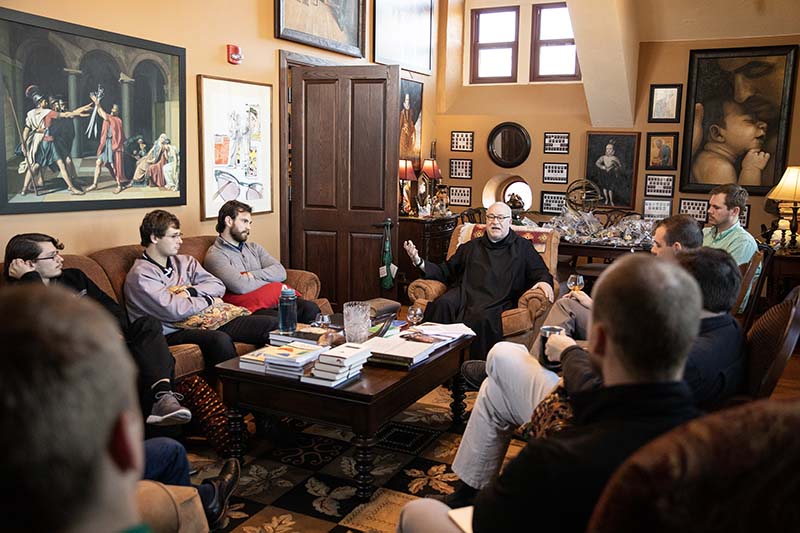Propaedeutic Year
Monday, January 30, 2023

New year of preparation added to seminary studies
As a freshman at Purdue University, Chase LaCoursiere was studying computer engineering and living his Catholic faith in name only. During the Covid years when many activities were canceled, he decided to dive deeper into his faith.
“I started reading things about the faith, and I kind of fell in love with that ... I would rush to get done with my computer engineering homework so that I could go read theology and philosophy,” Chase recalls.
As he got closer to earning his degree, he also realized that he had no real passion for computer engineering. He could do the work, but he didn’t have the desire he saw in his classmates.
That led Chase to continue his study of philosophy and theology. He affiliated with the Archdiocese of Indianapolis to study for the priesthood and learned he would be one of the 10 men attending Saint Meinrad’s first class of propaedeutic studies.
In some ways, Chase is the typical propaedeutic student: as a non-college-seminary student, he did not formally study theology or philosophy and was not part of a community with a spiritual focus.
“I enjoy the Catholic community here,” he says. “We’re all moving in roughly the same direction.” He appreciates the structure of the program, but also the free time. “I have plenty of time to do my reading that I like to do, in a great library where I can essentially go get any book I could ever want.”
A team of formation staff, instructors and faculty is piloting the propaedeutic year, which Saint Meinrad calls El Camino. “We wanted it to be viewed as a way of pilgrimage,” explains Dr. John Schlachter, academic coordinator for the propaedeutic year. “The participants would be on a spiritual pilgrimage throughout the year, learning more about themselves, their dioceses, and the Universal Church.”
The focus of the year is on spiritual and human formation, but El Camino includes some academics and ministry opportunities as well. Special days of recollection and rest are built into the schedule to give the men time to digest what they’re learning and reflect on their experiences, Schlachter explains. At the end of the year, there is a six-day walking pilgrimage to Santiago de Compostela.
“We have built into our program seminar-style sessions, where ideas are the main focus, and then they get a chance to put those ideas together in practice, in their prayer lives, and in their ‘Habits of Priestly Spirituality’ session,” he says. In those sessions, the instructor introduces concepts or practices of priestly formation and provides space for the students to talk about them and how they might be incorporated into their lives.
Fr. Luke Waugh, OSB, serves as the formation dean for the class, meeting with them weekly to see how their classes are going, answer any questions they have, and observe how well they are integrating the information they’re learning.
The students range in age from 21 to 31, Fr. Luke says. “Some of them are coming from jobs and careers,” with educational backgrounds ranging from theology to STEM (science, technology, engineering and math) degrees, like Chase. “There are several who have not been active in the Church for very long.”
To help the students come together as a community, they are housed on the same floor. They have their own dining room for meals and a separate chapel for daily Mass and prayer. On some days, they join the regular seminarian community for meals and Mass. They’ve also enjoyed some group social activities, such as a pitch-in dinner one evening.
Although he admits to being skeptical at first about the need for a propaedeutic year, Fr. Luke is quickly seeing the benefits for the students. “They’ve had time to focus on the human formation and the spiritual formation, in obtaining the tools of discernment – without the pressures of an academic component on top of it,” he says.
Also a member of the propaedeutic year team is Deacon John Wilebski. A transitional deacon in his final year of priesthood studies, Wilebski lives on the same floor with the propaedeutic students. As a seminarian further along the path to ordination, he can be a mentor and offer advice from his own experience.
For example, he’s a good resource for the practical questions that arise, such as how to use the breviary for daily prayer. At the beginning, some of the men needed help in figuring out the breviary, so Wilebski held an impromptu lesson on how to pray the Liturgy of the Hours.
During the first weeks of the new program, Wilebski has watched the men bond as a group. “Probably the strongest aspect of the program so far, with this particular group of men, is the community that they’ve been able to form with each other,” he says. That sense of community is forming them as well.
Wilebski believes the propaedeutic year allows these men to step away from their normal patterns outside of seminary. “Because of that, it’s bringing more clarity and discernment for them,” he says. “They’re discovering more of themselves that they maybe didn’t realize was there.”
Saint Meinrad offers lots of resources for the propaedeutic year, according to Wilebski, from spiritual direction and counseling to opportunities to visit parishes that reflect the diversity of the Catholic faith. “So while the big picture is oriented toward priesthood, they’re very much working on themselves and their relationship with God in this year.”